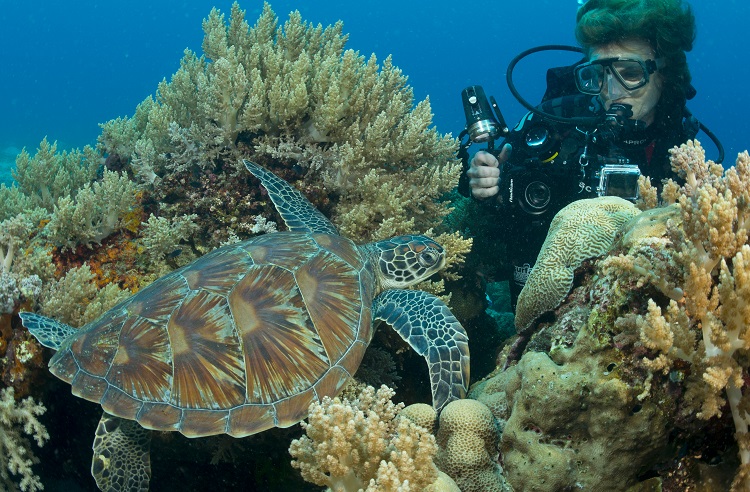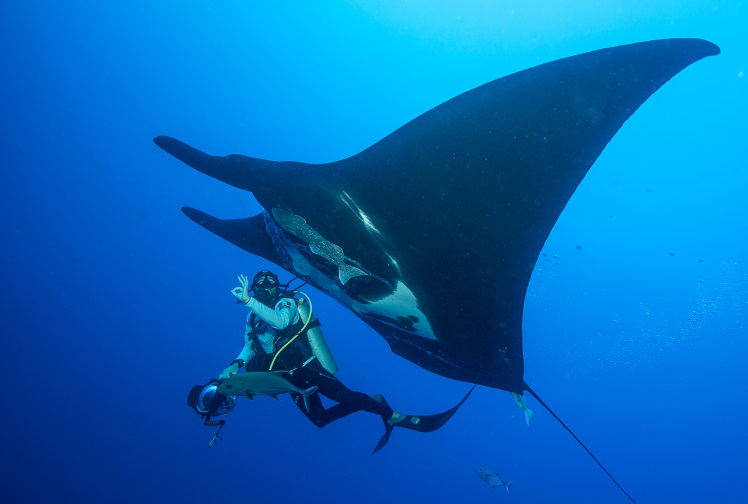Feeding Whale Sharks in the Philippines
11-Oct-2013 Back to Image Gallery
This 8 meter whale shark was just one of 10 being hand fed bait fish by the fishermen from the village of Oslob in the Visayas Islands. Our Dive 2000 group were enjoying an amazing encounter during our August 2013 trip aboard Philippine Siren. An encounter that cannot be experienced anywhere else in the world. Off the village of Oslob, local fishermen have routinely shared their catch with the local resident whale sharks as they believe it brings good luck. A synergy with creatures of the sea one rarely sees exhibited by fisherman. Consequently these whale sharks and the village fishermen have become a tourist attraction that brings in further income to an otherwise very poor community thus helping ensuring the future survival of these sharks which are otherwise destined to lose their fins (and their lives) for a bowl of soup. At one point I spun around 360 degrees and managed to count 10 whale sharks simultaneously feeding from the canoes around us. Everyone of my group had an abundance of whale sharks to keep them busy; every whale shark seemed to suckle from the canoes like a pack of contented puppies suckling on mothers teats. These gentle giants roamed amongst us sometimes gently brushing us aside to seek out food from the fishermen floating in their canoes above.
Photo Data: Location: Oslob Village, Visayas Islands, Philippines. Genre: Extreme Wide Angle Sunlight Photo Data: Nikon D800 with Nikkor 16mm Full frame fisheye lens, Seacam Housing & Superdome Port. Aperture Priority Exposure Mode. Sunlight Exposure ISO 400, Aperture F8 @ 1/500th Sec. Image by Kevin Deacon.
Photo Hints: The challenge for me was to capture a picture that told the story of the relationship between the sharks and the fishermen. I shot many images during the one hour interaction with them both and managed quite a few that I believe communicated this behaviour beautifully. In this image one can clearly see the vortex of water sucked into the feeding whale sharks mouth, the canoe above and the Fishermans toes making a gentle connection with the whale sharks chin. I believe that when one approaches a subject like this it is important to pre visualise `what is the story here, and how can I best tell it visually', then work damn hard to do that with a single frame captured in a split second.EQUIPMENT COMMENTS: Any underwater camera system is capable of capturing these pictures as long as a wide angle lens with a field of view (FOV) of 100 degrees or more is available. No strobes are required as the sunlight provides excellent lighting at or near the surface. In my case the 4 frames per second shooting speed of my Nikon D800 DSLR camera provided a distinct advantage in capturing the perfect moment. The optical perfection of the large glass dome on my Seacam housing also ensured a very sharp detail in the key areas of the picture. The use of Nikons Full Frame Fisheye lens with a FOV of nearly 180 degrees allowed me to shoot this image within 2 meters of the sharks thus ensuring a very clear picture as I was so close to the action.
Interesting Facts: Whale sharks are among the many species of sharks that are targeted for their fins. This year (2013) CITES, the organisation charged with listing species that a vulnerable to extension and should be prohibited from international trade, voted to protect 8 species of sharks and rays. This included whale sharks, Oceanic White Tip, three species of Hammerhead & both species of Manta Rays.



